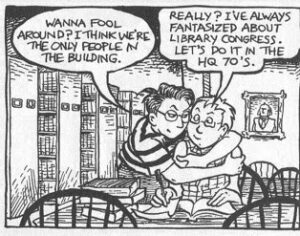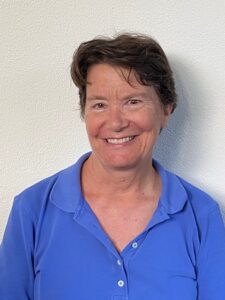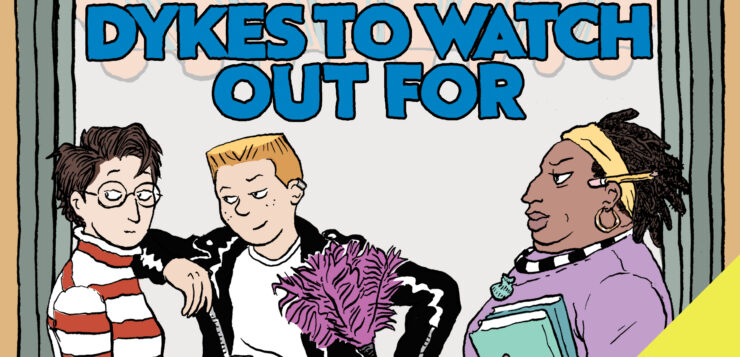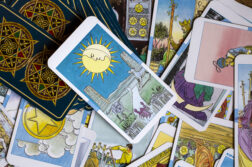
I was in college when the comic strip Dykes to Watch Out For (DTWOF) by Alison Bechdel first appeared in feminist newspapers in 1983. The next summer, I landed in San Francisco and began my adult life, renting an apartment with a roommate, working at a law firm as a paralegal, slowly piecing together a circle of friends, and trying to figure out my sexuality. Was I bisexual? Was I a lesbian? Was I still straight? Was there a name for someone who in the late 1970s had seen a poster of model Cheryl Tiegs in a bikini and felt thirsty, who had fantasized about kissing a friend in high school, who had been with men during college while cultivating friendships with ‘out’ lesbians and gay men, and who still, in her early twenties, had never slept with a woman? I eventually found my way to a job at a feminist press staffed entirely by lesbians. When one of them asked me when I had come out, I answered, “I haven’t yet.”
Meanwhile, DTWOF progressed from single-panel to multi-panel drawings about random lesbians, gently-mocking slices of life in a diverse queer community, and was syndicated in an increasing number of weekly LGBTQ and feminist papers. The growing cast of returning characters was often appealing, featuring some exasperating personalities who zealously discussed contemporary politics when they weren’t going through relationship troubles, struggling with identity issues, fumbling through therapy, or suffering at their various jobs. Bechdel herself described DTWOF as “half op-ed column and half endless, serialized Victorian novel.” It was a witty and rare exploration of lesbian existence that felt no need to explain itself to a larger, heteronormative world.

When I first read a DTWOF strip, probably given to me by an enthusiastic friend, there was nothing out there— certainly no comic strip —that described authentic lesbian lives with such clever detail and warm humor. While underground comic books written by women had circulated for years, more well-known lesbian comics and graphic novels such as Hothead Paisan and Jane’s World wouldn’t appear until the 1990s. As the years passed, Bechdel introduced more people of color, trans characters, disabled characters, and more into her comics. Throughout its 25-year run, the strip reflected the ways that lesbian culture was transforming, confidently handling issues of gender, ethics, race, sexuality, class, and diverse incarnations of family. The members of this growing community wrestled with the U.S. Presidents and politics of the 1980s through the mid-2000s. They were neurotic and sometimes took themselves too seriously, but they were also loyal, sympathetic, and funny.
I loved Bechdel’s comic strip because it reflected bits of my life and concerns, while showing me what a woman-centered community looks like. During much of the 1990s, I spent time in New York City. Out as a full-fledged lesbian by then, I met my first NYC dyke friends at Front Runners and through a writing class. I joined the Lesbian Avengers the year it was formed, in 1992, although I wasn’t an organizer by nature; I wheat-pasted announcements on street lights and sang altered Christmas carols in front of Trump Tower. At the first-ever Dyke March the night before the March on Washington for Lesbian, Gay and Bi Rights in 1993, I met the woman who would be my first long-term lover. Bechdel referenced the Avengers at least twice: in my much-paged-through edition of Unnatural Dykes to Watch Out For, an entire strip is given to the first Dyke March in New York City, that same year. One panel shows a raucous group of topless lesbians dancing on the march route, where someone is holding up a Lesbian Avengers flag. In another panel, one of the main characters wears a Lesbian Avengers t-shirt under her leather jacket, and a bulletin board sports an invitation to an Avenger Loft Party.
By then, those of us who were DTWOF fans could buy the paperback collections as they appeared. Firebrand Books, one of several lesbian feminist publishers that emerged at that time, published nine collections of Bechdel’s comic strips, which included New, Improved! Dykes to Watch Out For, Hot Throbbing Dykes to Watch Out For, and Split-Level Dykes to Watch Out For. After Firebrand shut down in 2000, Alyson Books published the last two collections of the series, Dykes and Sundry Other Carbon-Based Life Forms to Watch Out For and Invasion of the Dykes to Watch Out For. Sadly, all of these collections are now out of print. In 2008, the same year that Bechdel stopped publishing the strips in syndication, Random House brought out The Essential Dykes to Watch Out For, a hefty but incomplete compilation of the 25-year ongoing saga.
Bechdel became far more famous when her graphic memoir about her relationship with her father, Fun Home, became a national best seller. Are You My Mother? followed five years later, in 2013. That same year, Fun Home opened off Broadway as a musical. I saw it, skeptical about how a cartoon series could become not only a play, but one with songs. I thought it was phenomenal. After moving to Broadway in 2015, the musical won five Tony Awards, including Best Musical. And in 2021, Bechdel’s third graphic memoir, The Secret to Superhuman Strength, was published.
This year, the 40th anniversary of the appearance of DTWOF, another incarnation of Bechdel’s work is available on Audible: a ten-episode podcast series based on early episodes of the comic strip. The cast, director, and writer of the adaptation are all queer women. Among the famous names are Roxane Gay and Jane Lynch. Again, I was skeptical, wondering how a completely visual experience could be transformed into a story told solely through audio, but found the music and background sounds to be wonderful.
For me personally, the transition from the written word to spoken word was not successful. Not only because the work has shifted to a medium that has almost nothing in common with its predecessor, but because the voices are not convincing. The narrator, who gives context and bridges transitions, comes off as a stand-up comic instead of a wry commentator, and the various characters are undifferentiated, lacking the appearances and traits that the comic strip visibly provides. I am guessing that the podcast is intended for younger audiences, and audio and video enthusiasts who discovered Alison Bechdel through Fun Home. For these fans and those who are curious, the Audible version is a good entry into Bechdel’s earlier work, which provides a particular lesbian history that can be compared to how things stand today. I hope that those who listen will subsequently be drawn to the original comics, with their newspaper headlines that change from one panel to the next, the characters’ hilarious facial expressions, the intricate background details, and the surprisingly realistic bodies of women who are living in the best way they know how.
 Martha K. Davis is a writer, editor, and teacher living in San Diego, CA. Her novel Scissors, Paper, Stone received the inaugural Quill Queer Prose Award from Red Hen Press and was published in 2018. Her short stories and essays have appeared in StoryQuarterly, River Styx, Stone Canoe, Calyx, and other literary journals as well as in several anthologies. She received an MFA in Fiction from Columbia University, and she has been a resident at writers colonies such as Djerassi, Saltonstall, and VCCA. She is also a longtime contributor to The Gay & Lesbian Review.
Martha K. Davis is a writer, editor, and teacher living in San Diego, CA. Her novel Scissors, Paper, Stone received the inaugural Quill Queer Prose Award from Red Hen Press and was published in 2018. Her short stories and essays have appeared in StoryQuarterly, River Styx, Stone Canoe, Calyx, and other literary journals as well as in several anthologies. She received an MFA in Fiction from Columbia University, and she has been a resident at writers colonies such as Djerassi, Saltonstall, and VCCA. She is also a longtime contributor to The Gay & Lesbian Review.






